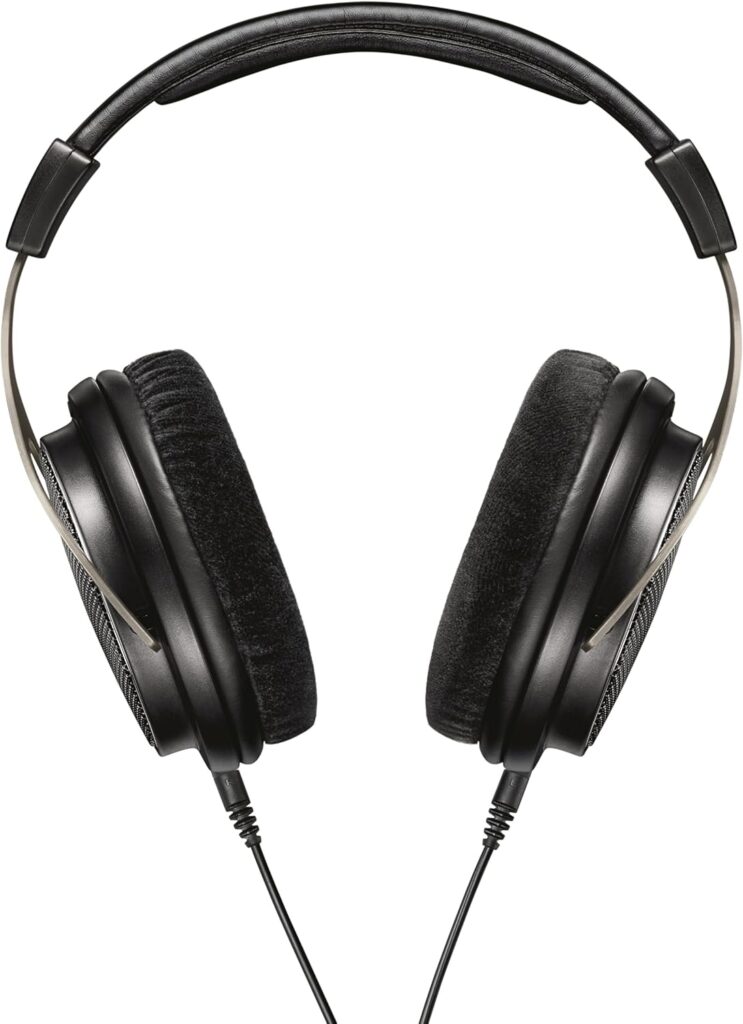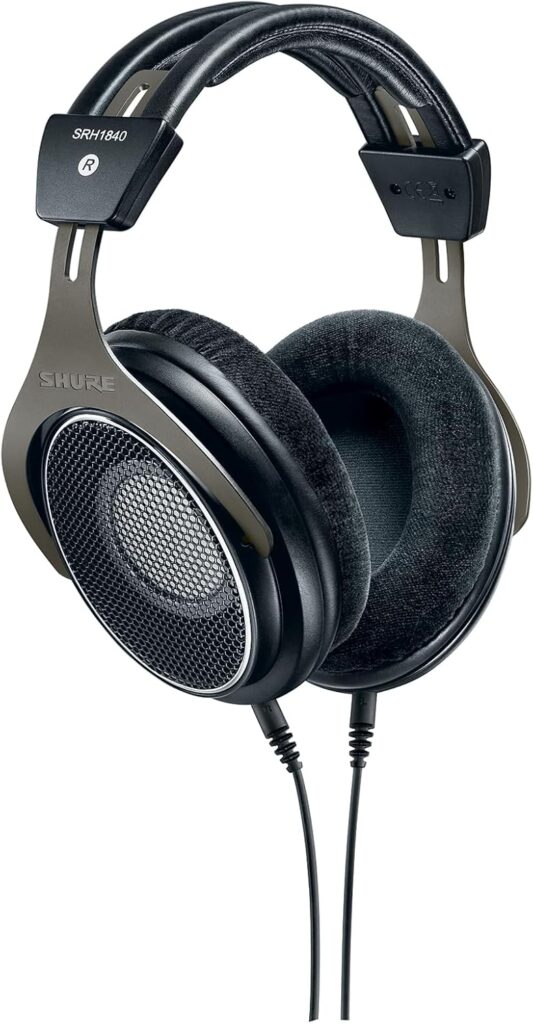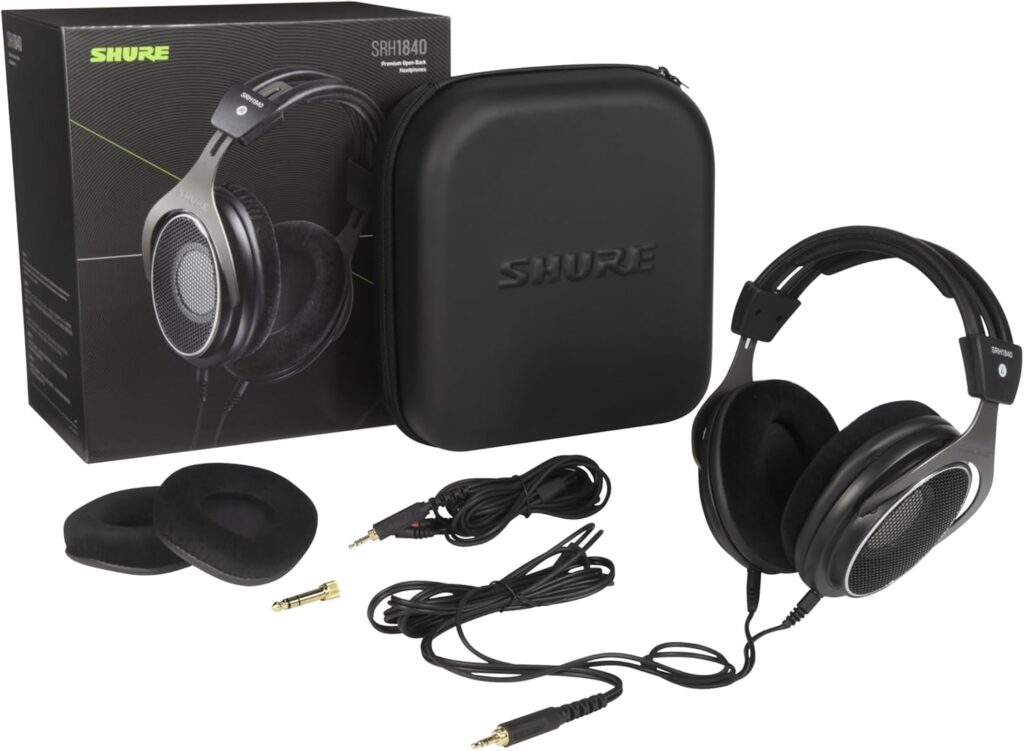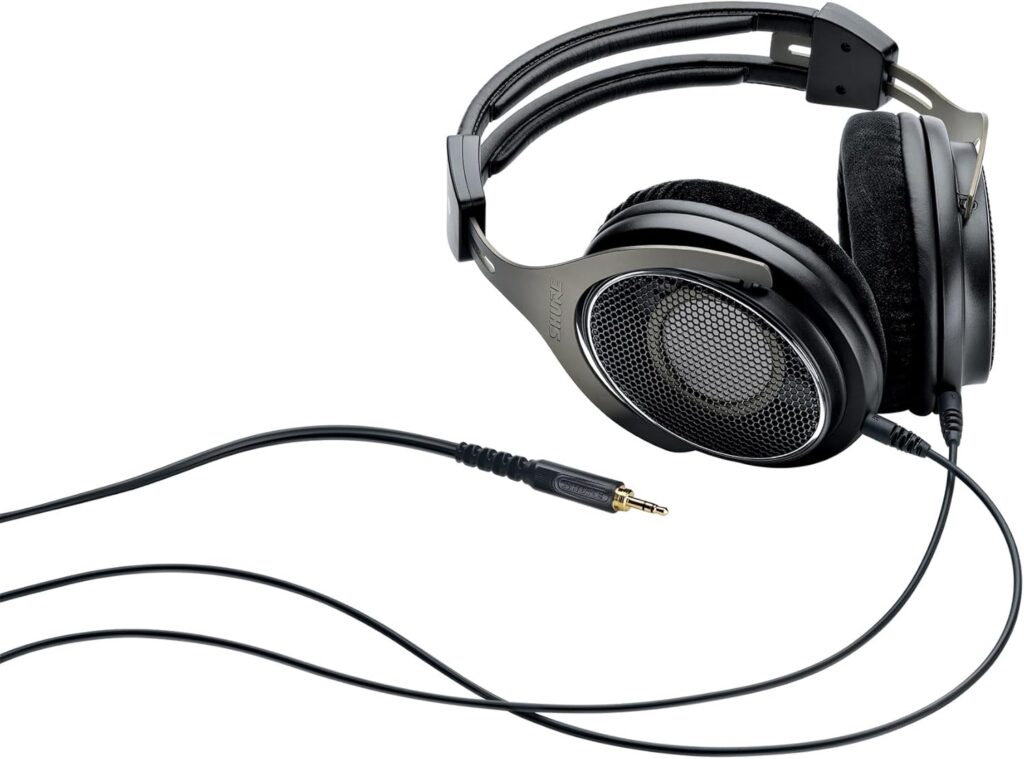Shure SRH1840 Review
When it comes to high-end audio equipment, Shure is a name that commands respect. Known primarily for their legendary microphones, Shure has steadily expanded into the headphone market, delivering products that blend precision engineering with exceptional sound quality. Among their offerings, the Shure SRH1840 stands out as a flagship open-back headphone designed for critical listening, mastering, and audiophile enjoyment. In this review, we’ll explore every facet of the SRH1840—its design, comfort, sound performance, and value proposition—to determine whether it lives up to its premium reputation and price tag.
Shure SRH1840 Review
The Shure SRH1840, introduced in 2012, represents the pinnacle of Shure’s headphone lineup at the time. Marketed as a professional-grade tool for studio use, these open-back headphones promise “unparalleled acoustic performance” with a focus on neutrality, clarity, and comfort. Priced around $500 (though originally retailing closer to $700), the SRH1840 competes with heavyweights like the Sennheiser HD650, Beyerdynamic DT990, and AKG K702, while remaining more affordable than flagship models like the Sennheiser HD800. But does it deliver a sound and experience worthy of its cost? Let’s break it down.
Unboxing and First Impressions
Shure knows how to make an entrance. The SRH1840 arrives in a large, luxurious black cardboard box that exudes a sense of occasion. Inside, you’ll find a padded, semi-hard carrying case that houses the headphones, along with a thoughtful accessory package: two detachable 6.9-foot Kevlar-reinforced cables with gold-plated MMCX connectors, a spare set of velour earpads, and a 1/4-inch adapter. This attention to detail signals Shure’s intent to cater to professionals and enthusiasts who value durability and long-term use.
The headphones themselves are strikingly minimalist yet elegant. The combination of a matte black finish, aircraft-grade aluminum yokes, and stainless-steel grilles gives them a sleek, understated aesthetic with a touch of industrial sophistication. At 268 grams (without the cable), they’re remarkably lightweight for their size, hinting at the comfort that awaits during extended listening sessions.
Design and Build Quality

The SRH1840’s design reflects Shure’s commitment to both form and function. The open-back configuration, featuring perforated stainless-steel grilles, allows sound to breathe freely, promising a natural, speaker-like listening experience. The headband is lightly padded with pleather, while the earpads are crafted from soft, breathable velour—a material choice that prioritizes comfort over the heat retention often associated with leather or faux-leather pads.
The build quality is top-notch. The aluminum yokes slide smoothly to adjust the fit, locking securely in place once on your head. The earcups are sturdy yet lightweight, and the detachable cables connect with a satisfying click, ensuring they won’t come loose unintentionally. Shure’s inclusion of a spare cable and earpads is a practical touch, acknowledging that wear and tear is inevitable over time. With a two-year warranty (twice the industry standard), Shure backs up its promise of durability, offering peace of mind for a significant investment.
However, the headband padding is minimal, which might raise concerns about long-term comfort for some users. In practice, though, the lightweight construction and balanced clamping force mitigate any potential discomfort, making the SRH1840 a headphone you can wear for hours without fatigue.
Comfort: A Studio Companion
Comfort is a critical factor for headphones designed for critical listening or studio work, where sessions can stretch into the wee hours. The SRH1840 excels here. Weighing just 268 grams, it’s lighter than many competitors, such as the Sennheiser HD650 (260 grams without cable) or Beyerdynamic DT990 (290 grams). The velour earpads are spacious enough to accommodate most ear sizes without pressing against them, and their breathability prevents the sweaty buildup that plagues closed-back designs.
The clamping force strikes a perfect balance—firm enough to stay in place during movement, yet gentle enough to avoid headaches or ear fatigue. Glasses-wearers will appreciate the lack of excessive pressure on the temples, a common complaint with tighter-fitting headphones. While the headband padding could be thicker, the overall weight distribution ensures it’s rarely an issue, even after marathon listening sessions.
For studio professionals or home listeners who value comfort as much as sound, the SRH1840 delivers a fit that feels almost invisible—a rare feat for over-ear headphones.
Technical Specifications
Before diving into the sound, let’s examine the SRH1840’s specs:
- Driver Type: 40mm neodymium, individually matched
- Impedance: 65 ohms
- Sensitivity: 96 dB/mW
- Frequency Response: 10 Hz – 30 kHz
- Cable: Dual-exit, detachable, 2.1 meters (6.9 feet)
- Weight: 268 grams (without cable)
- Design: Open-back, circumaural
With a moderate impedance of 65 ohms and relatively low sensitivity, the SRH1840 is easier to drive than high-impedance models like the Beyerdynamic DT990 (250 ohms) or Sennheiser HD650 (300 ohms). While it benefits from a dedicated headphone amplifier for optimal performance, it can still achieve decent volume levels with a quality DAP or laptop. This versatility makes it accessible to a broader range of users, from casual listeners to studio engineers.
Sound Performance: The Heart of the Matter
The SRH1840’s sound signature is its defining feature, and Shure has tuned it with precision in mind. Let’s break it down across the frequency spectrum.
Bass
Unlike Shure’s closed-back models (e.g., the SRH940), which often emphasize midrange at the expense of bass, the SRH1840 delivers a balanced low end. The bass is tight, well-defined, and fast, extending down to 20 Hz with audible presence, though it lacks the visceral punch of bass-heavy headphones like the Beats Pro. This restraint is intentional—Shure prioritizes accuracy over exaggeration, making the SRH1840 ideal for mixing and mastering, where bloated bass can obscure details.
Listening to tracks like Kyuss’s “Green Machine,” the bass guitar rumbles with texture and control, never overpowering the mids or bleeding into other frequencies. It’s a “quality over quantity” approach that audiophiles and professionals will appreciate.
Midrange
The midrange is where the SRH1840 shines. It’s rich, detailed, and forward without being aggressive, striking a natural tone that brings vocals and instruments to life. Whether it’s James Vincent McMorrow’s mournful croon in “Follow You Down to the Red Oak Tree” or the intricate guitar interplay in Metallica’s “Master of Puppets,” the mids reveal nuances with stunning clarity.
Compared to the Sennheiser HD650, which can sound slightly recessed in the mids, the SRH1840 feels more immediate and engaging. There’s no hint of muddiness or harshness—just a smooth, transparent presentation that makes it easy to pinpoint every element in a mix.
Treble
The treble is smooth and extended, reaching up to 30 kHz with finesse. It’s detailed without being piercing, avoiding the sibilance that plagues some analytical headphones (e.g., Beyerdynamic DT1990 Pro). Highs shimmer naturally—think of the cymbals in Led Zeppelin’s “Immigrant Song,” which cut through the mix with clarity but never fatigue the ears.
Some listeners might find the treble a touch restrained compared to brighter competitors like the AKG K702, but this tuning ensures long-term listenability, a crucial trait for studio work or extended enjoyment.
Soundstage and Imaging
As an open-back design, the SRH1840 offers a spacious soundstage that mimics the experience of listening to speakers. The stereo image is wide and deep, with excellent separation that allows instruments to occupy distinct positions. In Miles Davis’s “So What,” the interplay between trumpet, saxophone, and piano feels expansive yet precise, as if you’re seated in the recording room.
While not as vast as the Sennheiser HD800’s legendary soundstage, the SRH1840’s imaging is pinpoint-accurate, making it a stellar choice for critical listening. The open-back design does mean sound leaks both in and out, so it’s best suited for quiet environments rather than public spaces.
Overall Sound Signature
The SRH1840’s sound can be summed up as neutral yet musical. It doesn’t hype any frequency band, delivering a flat response that’s faithful to the source material. This neutrality makes it an exceptional reference tool, but its warmth and refinement ensure it’s enjoyable for casual listening too. It’s a rare headphone that bridges the gap between analytical precision and emotional engagement.
Comparisons to Competitors
To put the SRH1840 in context, let’s compare it to some peers:
- Sennheiser HD650: The HD650 offers a warmer, more laid-back sound with stronger bass but less treble extension. The SRH1840 feels more neutral and detailed, with a wider soundstage.
- Beyerdynamic DT990 (250 ohms): The DT990 has a brighter, V-shaped signature with boosted treble and bass. The SRH1840 is smoother and more balanced, though less dynamic for some tastes.
- AKG K702: The K702 emphasizes treble and soundstage but can sound clinical. The SRH1840 is warmer and more natural, with better bass control.
The SRH1840 carves its niche as a “Goldilocks” headphone—neither too warm nor too bright, striking a balance that suits a wide range of genres and applications.
Practical Considerations
Drivability
With 65 ohms impedance and 96 dB/mW sensitivity, the SRH1840 is relatively easy to drive. A portable player like the FiiO X3 can power it adequately, but pairing it with a headphone amp (e.g., FiiO A3 or Schiit Magni) unlocks its full potential, enhancing dynamics and bass authority.
Use Cases
The SRH1840 is purpose-built for studio monitoring, mastering, and home listening. Its open-back design rules out use in noisy environments or recording booths, where sound leakage could interfere with microphones. For audiophiles seeking a transparent, fatigue-free experience, it’s a dream come true.
Value Proposition
At $500, the SRH1840 isn’t cheap, but its combination of sound quality, build, and accessories justifies the cost for professionals and serious enthusiasts. It’s a step below the $1000+ tier of flagship headphones (e.g., HD800, Focal Utopia) yet outperforms many mid-tier options, offering exceptional value in its class.
Pros and Cons
Pros
- Neutral, detailed sound with a musical edge
- Lightweight and comfortable for long sessions
- Premium build quality with spare parts included
- Wide, natural soundstage
- Easy to drive compared to high-impedance rivals
Cons
- Minimal headband padding may bother some
- Open-back design limits portability and isolation
- Bass lacks the punch some listeners crave
- Price may deter casual buyers
Conclusion: Is the Shure SRH1840 Worth It?
The Shure SRH1840 is a triumph of engineering and sound design. It delivers a listening experience that’s both analytical and enjoyable, making it a versatile tool for studio professionals and audiophiles alike. Its neutral tuning, exceptional clarity, and spacious soundstage set it apart in a crowded market, while its lightweight build and thoughtful accessories ensure it’s a long-term investment.
Is it perfect? No headphone is. Bass enthusiasts might find it too restrained, and its open-back nature restricts its use to controlled environments. But for those seeking a reference-grade headphone that balances accuracy with musicality, the SRH1840 is a standout choice. It’s not just a headphone—it’s a window into the soul of your music, revealing details you never knew existed.
If you’re in the market for a premium open-back headphone and can accommodate its quirks, the Shure SRH1840 deserves a spot on your shortlist. Audition it if possible; you might find it’s the last headphone you’ll ever need.




